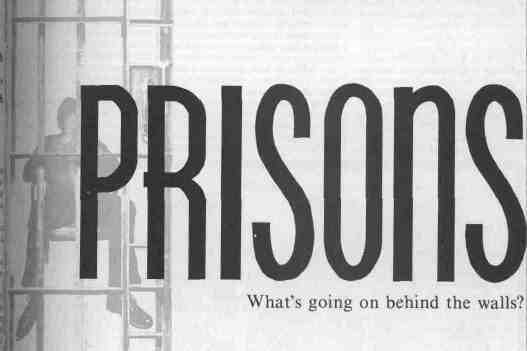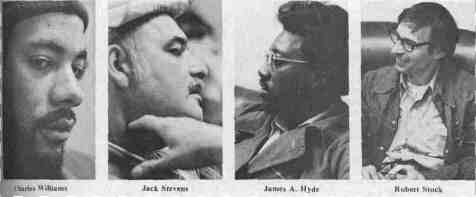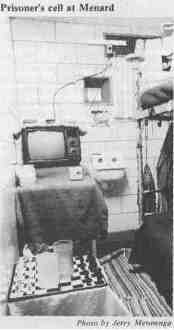
WHAT are prisons for? Are they places where wrongdoers are corrected and rehabilitated, or are they designed only to "pen" and punish criminals? The consensus among corrections personnel seems to be that Illinois prisons are primarily functioning for the purpose of confinement: "I don't think any rational person can indicate that anything but punishment is the main reason for prisons," Illinois Department of corrections Director Charles J. Rowe says. But he adds, "It's not the sole reason. We're trying to return offenders to society as constructive citizens."" Such reform is mandated by the state Constitution, which says in Article I, Section 11, "All penalties shall be determined both according to the seriousness of the offense and with the objective of restoring the offender to useful citizenship." But what kind of job are they doing? Secondly, who are prisons for? Before they existed, criminals were fined if they were too rich to be whipped, and whipped if they were too poor to be fined. Is economic status now a barrier to equal justice? Since prisons are so largely ignored, they develop huge, grotesque excesses from time to time. The press, or other reformers, find out and tell us about the filth or overt cruelty going on and we click our tongues (it's just what we had always suspected). Incremental reforms are forever forthcoming; some actually improve conditions behind bars, most only complicate matters for awhile. It is probably not demonstrable that generations of penal reform have brought any absolute progress toward relieving human suffering in average American prisons.
Overcrowding in prisons But, nationwide, 40 states are experiencing similar critical prison overcrowding, according to Corrections Magazine (March 1977). Conditions in Illinois prisons are not very good. A study prepared for the Illinois Department of Corrections last May recommended that the four largest prisons in the state should be abandoned, since they are dilapidated and dangerous to inmates and staff. It also called the Menard Branch of the Illinois State Penitentiary "one of the worst prisons in the United States." That report, issued by the National Clearinghouse for Criminal Justice Planning and Architecture, was almost immediately suppressed, disputed and repudiated by the state corrections department. Director Charles J. Rowe said, "The report lost touch with reality in terms of what this state can afford. Philosophically I'm not in disagreement with the plan, but I'm afraid there were too many very bright young people, just out of college, writing this thing and the results were not very practical." Rowe claims that March 1978/ Illinois Issues/ 7 enacting the plan put forward by the Clearinghouse would result in only 6,000 beds for prisoners in Illinois at a cost of $850 million.
Building new prisons The two new pens will both be located downstate, at Hillsboro and Centralia, despite calls from prison reform groups like the John Howard Association and the American Civil Liberties Union asking that at least one new prison be built in the Chicago area. Since Chicago is the place where most of the prisoners in Illinois come from, there was pressure to build a prison nearby so that relatives could more easily visit inmates, and so that the guards and staff of the prison would have more in common with the prisoners. But the selection process, aimed at finding acceptable sites as quickly as possible, dismissed upstate locations. The Thompson administration called for counties and communities to submit survey forms if they were interested in having a prison located nearby. No Chicago-area communities applied. There were 20-odd applicants. All those north of Springfield were rejected after public hearings held in the 17 places that seemed to qualify as sites. In some cases the promoters of the sites simply changed their minds. In other cases the
8 /March 1978 / Illinois Issues public reaction was so strong against building a prison in the area that it seemed hopeless to press on. Opponents of a proposed prison site in East St. Louis included many inmates at Menard Correctional Center from the East St. Louis area. "I would detest a flock of hardened criminals around my family or even closer to them," said one inmate in a letter to a local newspaper. "I cannot believe that my fellow citizens would consign the future of their children to such a fate," said another. But the sites have now been chosen and new prisons will be built and filled: two 750-bed prisons. The new prisons will probably be filled to overcrowding as soon as they are completed. It is a rule of prisons that no space is ever left vacant. Illinois already has enough prisoners to assure that the rule won't be broken soon. Yet the state may generate more prisoners, and keep them behind bars longer, under the new "Class X" sentencing law (P.A. 80-1099) — which took effect February 1. According to Jeanette Musengo, associate director of the Illinois Prisons and Jails Project (a privately-funded reform group), "Initially Class X won't have any effect. We'll have to wait and see how judges use it, especially the discretionary powers — they'll have to double the maximum sentence for heinous crimes and repeat offenders." Some prisoners, of course, will be released early if they opt for a fixed sentence and get day-for-day good time.
Growing problems
March 1978/ Illinois Issues/9 expected to grow by several thousand by 1980, with up to 17,000 inmates by 1985. Even to relieve present overcrowded conditions and meet federal standards would cost the state "at least a billion dollars," estimates Musengo. Conditions in Illinois prisons are such that at Stateville, near Joliet, prisoners live three to a cell in an eight-by-five foot cell designed for one prisoner. "You can't guarantee anybody's safety in a place like this," says Warden Ernest E. Morris of Stateville. Reports of extortion, gang rule, homosexual rape, heatings and stabbings are not uncommon in Stateville, or in any other maximum-security prison. If one is locked up at Joliet, Stateville, Menard or Pontiac, the state is no longer really in charge. The state will only guarantee food and clothing, and the food will not always be good tasting and the clothing may not always be clean. The state apparently cannot guarantee a prisoner a regular shower, decent medical care, working toilets or physical protection. Some prisoners have jobs inside and some outside, some have exercise programs or sports. There are psychiatric specialists, counselors and chaplains. There are prison newspapers, movies, art classes, vocational courses, prison libraries and transactional analysis sessions, but there are no vacations. The deadening boredom and paradoxical threat of violence are constants of life behind bars.
Reducing prison size These are the prisons that the national clearinghouse recommended be torn down or radically altered. Unfortunately, these are the four prisons that house the most prisoners — more than 80 per cent of the state's 10,450. The clearinghouse report was also critical of all the medium-security prisons in the state, finding the only "satisfactory" prisons were the small ones: Vienna (with 579 prisoners), Sheridan (325), Dwight women's prison (269) and Vandalia (an "honor farm" with 643 inmates). Unfortunately, these small prisons are also the most expensive ones. The annual cost per inmate at Vienna is $10, 346, at Sheridan $12, 062, at Dwight $13, 317; whereas at Stateville the annual cost per prisoner is only $5, 575, and at Menard only $5, 094, and so on.
Expanding further Yet, Stateville and Menard come nowhere near meeting the standards for safety, cleanliness and roominess imposed by federal judges in Alabama and elsewhere. Thus, prison officials here think it likely that the courts may order a large transfer of prisoners from the four big, bad maximum-security prisons. Others have suggested the likelihood of federal court intervention in the running of the system itself. The question may then arise as to whether the two new 750-bed prisons will have to hold more people than planned, and whether there will be enough room elsewhere. The corrections department has already begun to solve the second problem. It is converting ing a developmental center at Lincoln into a 700-bed medium-security prison. Another 350 beds will also be made available from expansions at Sheridan, Dwight and Pontiac. Construction of a medium-security prison at Eddyville in Pope County may also come next year, according to Gov. James R. Thompson, if funds are available.
Deterring crime Still, there is value in prisons as places of punishment, according to Harvard professor James Q. Wilson. Wilson believes that the higher the probability there is of punishment, the greater will be the reduction in the crime rate. Wilson also says that juvenile offenders 10/ March 1978/ Illinos Issues should be imprisoned more often, since they show the highest rate of recidivism to crime. Others have different views. Reform groups say that alternatives should be found to imprisonment for most offenders — those who are not already "hardened" to a life of crime. They say that probation, work-release and community help programs are more effective than the pen. "I've been a prison warden and I don't know whether rehabilitation is any panacea, but one thing's for sure. You can't have people sitting on their asses from three to five years," says William Nagel, director of the American Foundation's Institute of Corrections. "You're preparing them for nothingness," he says. Michael Mahoney of the John Howard Association believes that up to half of those in prison in Illinois now could be released without menacing society. Probation and community alternatives are favored by his organization, as well as by the President's Crime Commission, the National Advisory Commission on Criminal Justice and Goals, the Advisory Commission on Intergovernmental Relations and the National Council on Crime and Delinquency.
Looking at inmates The same study also showed that 58 per cent of all prisoners in this state are black, while blacks make up only 13 per cent of the total population. Robbery is the most common crime that puts a man or woman in an Illinois prison; robbery accounts for 28 per cent of prisoners' sentences. The second most common crime is burglary, which brings 16 per cent of all sentences in Illinois. Moreover, black prisoners are given longer sentences and serve more time than whites. Asked why this was, state Corrections Director Rowe said, "I honestly don't know what that indicates. The percentage is going down [the last survey showed that only 53 per cent of prisoners were black]. I suppose that it's because a lot of our cases come out of Cook, and many can't afford a top-notch legal defense." Figures indicate that blacks are more likely to be imprisoned for crimes of violence than whites, who are typically sentenced for property crimes, like burglary. Robbery is the most common crime for which black people are incarcerated. Armed robbery is one of the Class X crimes for which lawbreakers will be put away an average of nine years (if they keep all their day-for-day good time). This is an increase of 5.2 years from the average number of years that used to be served for Class X-type crimes. The prison population in Illinois is expected to grow by several thousand by 1980, with up to 17, 000 inmates by 1985 Underlying the problem of unequal sentencing of minorities are economic inequities. Prime among these is joblessness, which traditionally runs three times higher among blacks than among whites, and even higher among young blacks. "Underemployment" — in low-paying jobs — is also a problem. Another underlying cause of crime is undereducation. Illinois does not have complete figures on such things, but data from other states indicates that the typical inmate is a high school dropout with little more than two years of secondary education.
Improving prison life But how can prisons themselves be improved? The solutions all seem to be expensive. Building many new prisons or improving existing ones so that inmates have room to breathe, or increasing the size and quality of treatment programs would cost the state money it apparently does not have. Funding may even be an obstacle to the institution of private conjugal visits or family visits for unmarried prisoners. Such concepts are continually before the Illinois legislature, and money is always an argument against them, as is the fear of being "soft" on criminals. Proponents say conjugal visits would assuage the problem of marriages that dissolve when one spouse is imprisoned for a long period of time. Others ask why sexual privileges are denied prisoners at all, since sex is a recognized human need. But advocates admit that it would cost several thousand dollars at each prison to set up rooms or trailers where any visits could take place. "If it comes down to a choice between funding prisons or funding schools, I'd have a hard time picking prisons," admits state Corrections Director Rowe. Inmate Robert Russo offered an alternative last December in a Menard (prison) Time column. Russo wrote: "A few years back Holland proclaimed to the world (though few listened) that it had dropped by over one-half the number of people confined within its prison system. It seems the judges . . . decided they would give out 'short,' not long, sentences. No one got over four years — not matter what they did — and most walked the streets again within a year. Careful and detailed studies of the consequences to the community revealed that there were no increases in crime; no rise in murder, rape or other heinous crimes; no skyrocketing burglaries, robberies and the like. The underlying secret of Holland's success was providing the prisoners with 'employable skills' and a good transitional program that put them in the natural environment as quickly as possible .... Just as a by-product, millions and millions of taxpayer dollars were saved." Of course, most people would not sympathize with such a 'mollycoddling' approach to crime. "The public," says John Grider, deputy director of the Oklahoma corrections system, "would like you to dig holes in the ground, lower the inmates into the hole on a rope ladder and then pull up the ladder." March 1978 / Illinois Issues/ 11 |
||||||||||||||||


